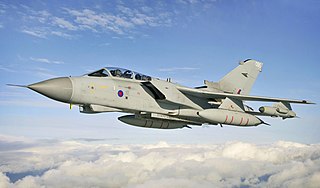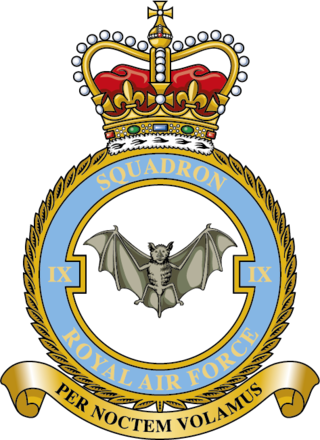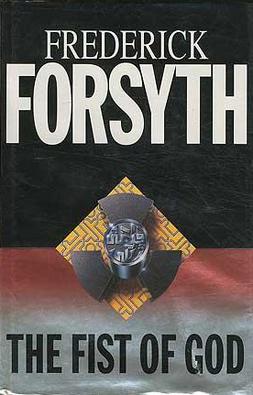Related Research Articles

The Panavia Tornado is a family of twin-engine, variable-sweep wing multi-role combat aircraft, jointly developed and manufactured by Italy, the United Kingdom and Germany. There are three primary Tornado variants: the Tornado IDS (interdictor/strike) fighter-bomber, the Tornado ECR SEAD aircraft and the Tornado ADV interceptor aircraft.

Operation Granby, commonly abbreviated Op Granby, was the code name given to the British military operations during the 1991 Gulf War. 53,462 members of the British Armed Forces were deployed during the conflict. Forty-seven British personnel were killed during Op Granby and many more were injured during the hostilities there. The total cost of operations was £2.434 billion (1992), of which at least £2.049 billion was paid for by other nations such as Kuwait and Saudi Arabia; £200 million of equipment was lost or written off.

Royal Air Force Leeming or more simply RAF Leeming is a Royal Air Force station located near Leeming, North Yorkshire, England. It was opened in 1940 and was jointly used by the RAF and the Royal Canadian Air Force (RCAF). Between 1950 and 1991, it operated mostly as a training base with Quick Reaction Force (QRF) Panavia Tornado F3 fighters based there in the latter stages of the Cold War and into the early 21st century. Since 2006, it has become the home of the deployable RAF communications cadre and the home of No. 135 Expeditionary Air Wing.

Royal Air Force Fairford or more simply RAF Fairford is a Royal Air Force (RAF) station in Gloucestershire, United Kingdom. While being an RAF station, Fairford hosts United States Air Force personnel. Since 2019, the base has played host to a Lockheed U-2S Dragon Lady detachment from the 99th Expeditionary Reconnaissance Squadron. It is the USAF's only European airfield for heavy bombers and routinely supports Bomber Task Force (BTF) operations. Its most prominent use in recent years has been as an airfield for United States Air Force B-52s during the 2003 Iraq War, Operation Allied Force in 1999, and the first Gulf War in 1991.

Number 17 Squadron, currently No. 17 Test and Evaluation Squadron (TES), is a squadron of the Royal Air Force. It was reformed on 12 April 2013 at Edwards Air Force Base, California, as the Operational Evaluation Unit (OEU) for the Lockheed Martin F-35B Lightning.

Number 9 Squadron is the oldest dedicated Bomber Squadron of the Royal Air Force. Formed in December 1914, it saw service throughout the First World War, including at the Somme and Passchendaele. During the Second World War, No. IX (B) Squadron was one of two Avro Lancaster units specialising in heavy precision bombing and sank the battleship Tirpitz on 12 November 1944 in Operation Catechism. Between 1962 and April 1982, the squadron flew the Avro Vulcan B.2 as part of the V-Force. In June 1982, it became the first front-line squadron in the world to operate the Panavia Tornado GR.1. In May 1998, No. IX (B) Squadron received the RAF's first Tornado GR.4, which it operated until reequipping with the Eurofighter Typhoon FGR.4 at its present home base of RAF Lossiemouth on 1 April 2019.

Number 31 Squadron, known as the Goldstars, is a squadron of the Royal Air Force. The Squadron lays claim to being the first military unit to fly in India, where it was based from 1915 to 1947. Throughout the Cold War, No. 31 Squadron was based in West Germany, flying from RAF Laarbruch and RAF Brüggen. Between September 1984 and March 2019, the Goldstars operated the Panavia Tornado GR1/4, initially from RAF Brüggen and after August 2001 from RAF Marham, Norfolk. No. 31 Squadron was disbanded on 14 March 2019 at RAF Marham and reformed on 11 October 2023 at RAF Waddington, Lincolnshire, equipped with the General Atomics Protector RG1.

Number 13 Squadron, also written as XIII Squadron, is a squadron of the Royal Air Force which operate the General Atomics MQ-9A Reaper unmanned aerial vehicle from RAF Waddington since reforming on 26 October 2012. The unit first formed as part of the Royal Flying Corps on 10 January 1915 and went on to fly the Martinsyde G.100, the Royal Aircraft Factory F.E.2, the SPAD VII and SPAD XIII, the Sopwith Dolphin during the First World War. In the Second World War it started out operating the Westland Lysander for army cooperation. From late 1942 it used Blenheims in North Africa but in 1943 squadron converted to Ventura for coastal patrols and convoy escort duties. Post war it operated Mosquito before transitioning to the new jet aircraft Gloster Meteor and English Electric Canberra for photoreconnaissance. From 1 January 1990, it operated the Panavia Tornado, initially the GR1A at RAF Honington and later the GR4/4A at RAF Marham where it temporarily disbanded on 13 May 2011.

Number 15 Squadron, sometimes written as No. XV Squadron, was a squadron of the Royal Air Force. It most recently operated the Panavia Tornado GR4 from RAF Lossiemouth as No. XV (Reserve) Squadron. It was the RAF's Operational Conversion Unit for the Tornado GR4 which taught pilots and Weapon Systems Officers (WSO) how to fly the aircraft and what tactics to use to best exploit the performance of their aircraft and its weapons.

No. 41 Squadron Royal Air Force is a flying squadron of the Royal Air Force (RAF), currently operating as the Test and Evaluation Squadron (TES) for the RAF's Typhoon, presently based at RAF Coningsby in the English county of Lincolnshire in the United Kingdom. Its current official abbreviated title is 41 TES. The squadron was originally formed in April 1916, during First World War as part of the Royal Flying Corps (RFC), and served on the Western Front as a ground attack and fighter squadron. Disbanded in 1919 as part of the post-war draw down, No. 41 Squadron was re-formed as an RAF squadron in 1923, and remained on home service until 1935, when it was deployed to Aden during the Abyssinian crisis.

The Fist of God is a 1994 suspense novel by British writer Frederick Forsyth, with a fictitious retelling of the Iraqi Project Babylon and the resulting "supergun".

Royal Air Force Germany, commonly known as RAF Germany, and abbreviated RAFG, is a former command of the Royal Air Force (RAF) and part of British Forces Germany (BFG). It consisted of units located in Germany, initially in what was known as West Germany as part of the British Air Forces of Occupation (BAFO) following the Second World War, and later as part of the RAF's commitment to the defence of Europe during the Cold War. The commander of RAFG doubled as commander of NATO's Second Allied Tactical Air Force (2ATAF). Its motto was 'Keepers of the Peace'.

Maurizio Cocciolone is an Italian Air Force officer, who served with UN Coalition forces and was a prisoner of war during the Gulf War.
Squadron Leader John Peters is a former pilot of the Royal Air Force (RAF).
Squadron Leader Paul Mason, known as Pablo Mason, is a retired Royal Air Force pilot, who was part of the XV Squadron detachment to Bahrain as part of the RAF Tornado squadron during the Gulf War, and subsequently wrote about his experiences. Mason is known for his handlebar moustache, and his Biggles-like attitude and persona.
Stalag Luft I was a German World War II prisoner-of-war (POW) camp near Barth, Western Pomerania, Germany, for captured Allied airmen. The presence of the prison camp is said to have shielded the town of Barth from Allied bombing. About 9,000 airmen – 7,588 American and 1,351 British and Canadian – were imprisoned there when it was liberated on the night of 30 April 1945 by Soviet troops.
No. 107 Squadron RAF was a Royal Flying Corps bomber unit formed during the First World War. It was reformed in the Royal Air Force during the Second World War and was operational during the Cold War on Thor Intermediate Range Ballistic Missiles.
Ar Rumaylah Southwest Air Base is a former Iraqi Air Force base in the Basra Governorate of Iraq.

Shaibah Air Base is an Iraqi Air Force airfield in the Basrah Governorate of Iraq.
References
- ↑ Independent article
- ↑ "121 Sqn. ATC – News – Pablo Mason". Archived from the original on 3 March 2016. Retrieved 9 October 2007.
- ↑ BBC News – 1991: Tornado down
- ↑ The Last Escape – John Nichol, Tony Rennell – 2002 Penguin UK Archived 20 February 2014 at the Wayback Machine
- ↑ "Flight Lieutenant John Nichol | speakers | Celebrity speakers | Speakers UK". Archived from the original on 5 February 2012. Retrieved 16 April 2007.